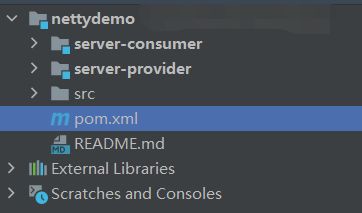今天翻看了一下Netty相关的知识点,正好练练手,简单捣鼓了这个demo;这里简单梳理一下;
前提知识点:
Springboot、 Netty、动态代理(反射)、反射
项目整体结构如下:
1.在父项目中引入相关依赖;
org.springframework.boot spring-boot-starter-web 2.3.2.RELEASE io.netty netty-all 4.1.48.Final com.alibaba fastjson 1.2.58 org.slf4j slf4j-log4j12 2.0.0-alpha1
2.服务提供模块整体结构如下:
这里重点关注一下 RequestModel 和 ResponseModel 两个消息体类,
@Data
@AllArgsConstructor
public class RequestModel {
private String requestId;
private String serviceName;
private String methodName;
private Class[] paramTypes;
private Object[] paramValues;
}
@Data
@AllArgsConstructor
public class ResponseModel {
private String responseId;
private String serviceName;
private String methodName;
private String code;
private String data;
}
用于服务端和客户端的数据传输;再者就是关注 ServerChannelInboundHandler 中的 channelRead0() 报文解码处理;
@Override
protected void channelRead0(ChannelHandlerContext ctx, String msg) {
StringBuilder sb = null;
RequestModel result = null;
try {
// 报文解析处理
sb = new StringBuilder();
result = JSON.parseObject(msg, RequestModel.class);
requestId = result.getRequestId();
String serviceName = result.getServiceName();
String methodName = result.getMethodName();
Class[] paramType = result.getParamTypes();
Object[] paramValue = result.getParamValues();
System.out.println(serviceName + " " + methodName);
String substring = serviceName.substring(serviceName.lastIndexOf(".") + 1);
String s = substring.substring(0, 1).toLowerCase() + substring.substring(1);
Object serviceObject = applicationContext.getBean(s);
Method method = Class.forName(serviceName).getMethod(methodName, paramType);
Object returnValue = method.invoke(serviceObject, paramValue);
ResponseModel responseModel = new ResponseModel(requestId,serviceName,methodName,"200",JSON.toJSONString(returnValue));
sb.append(JSON.toJSONString(responseModel));
sb.append("\n");
System.out.println(sb.toString());
ctx.writeAndFlush(sb);
} catch (Exception e) {
ResponseModel responseModel = new ResponseModel(requestId,"","","500",e.getMessage());
String errorCode = JSON.toJSONString(responseModel)+"\n";
log.error(errorCode);
ctx.writeAndFlush(errorCode);
log.error("报文解析失败: " + e.getMessage());
}
}
客户端的模块代码如下;
这里重点关注的是 ClientHandler 类中 channelRead0() 方法的处理
@Override
protected void channelRead0(ChannelHandlerContext ctx, String msg) {
System.out.println("收到服务端消息: " + msg);
ResponseModel responseModel = JSON.parseObject(msg,ResponseModel.class);
String responseId = responseModel.getResponseId();
Promise promise = LocalPromise.promiseMap.remove(responseId);
if(promise != null){
String code = responseModel.getCode();
if(code.equals("200")){
promise.setSuccess(responseModel.getData());
}else{
promise.setFailure(new RuntimeException(responseModel.getData()));
}
}
}
和 AppStart 类中获取获取服务的处理;
privateT getProxyService(Class serviceClass) { Object service = Proxy.newProxyInstance(serviceClass.getClassLoader(), new Class[]{serviceClass}, new InvocationHandler() { @Override public Object invoke(Object proxy, Method method, Object[] args) throws Throwable { Channel channel = NettyClient.getChannel(host, port); RequestModel requestModel = new RequestModel("100001", method.getDeclaringClass().getName(), method.getName(), method.getParameterTypes(), args); channel.writeAndFlush(JSON.toJSONString(requestModel) + "\n"); Promise promise = new DefaultPromise(channel.eventLoop()); LocalPromise.promiseMap.put(requestModel.getRequestId(), promise); System.out.println(LocalPromise.promiseMap+">>>>>>>>>>>>"); promise.await(); if (promise.isSuccess()) { Class returnType = method.getReturnType(); return JSON.toJavaObject(JSON.parseObject(promise.getNow()+""),returnType); } else { System.out.println(promise.cause()); return promise.cause(); } } }); return (T) service; }
测试结果:
总结: 这个demo相对比较简单,但对于理解rpc 远程调用有一定帮助,最后分享一下这个代码地址:
nettydemo: netty springboot rpc远程调用demo
到此这篇关于基于Springboot+Netty实现rpc功能的文章就介绍到这了,更多相关Springboot Nett实现rpc内容请搜索脚本之家以前的文章或继续浏览下面的相关文章希望大家以后多多支持脚本之家!




